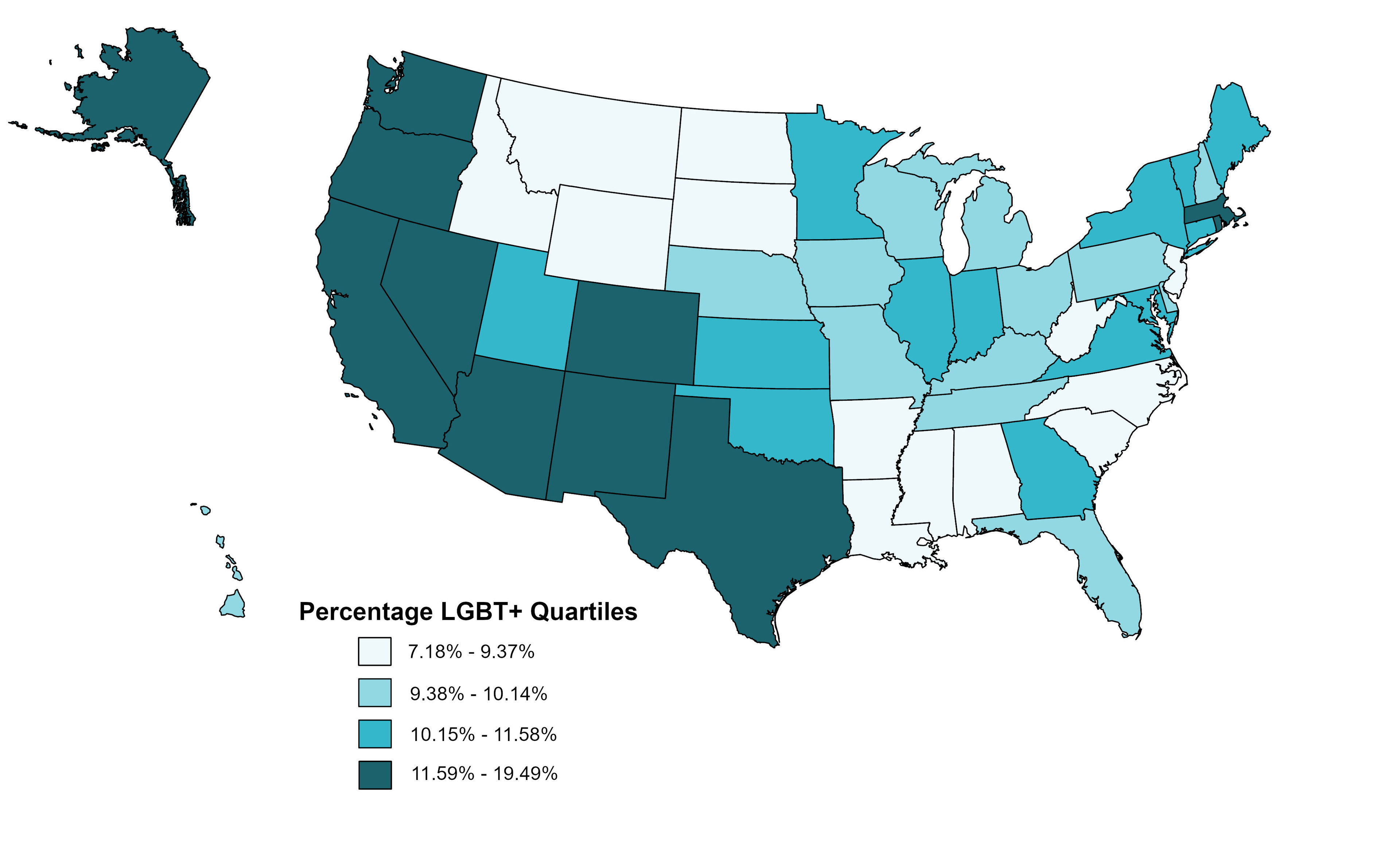Geographic Variation in LGBT+ Identification in the U.S.
Family Profile No. 05, 2023
Author: Christopher A. Julian
In this Family Profile we explore the geographic variation of LGBT+ identification in the United States using the U.S. Census Bureau’s Household Pulse Survey (HPS). Importantly, we move beyond the prevailing focus on same-sex couples to examine the entire LGBT+ identifying population. This profile complements other NCFMR profiles based on Census data products (e.g., American Community and Current Population Survey) that focus on same-sex couples (Payne & Manning, 2021; Payne & Manning, 2021). The HPS was designed to measure the experiences of American households during the coronavirus pandemic (for more information, visit the Census Bureau Website). The HPS consists of “phases” that constitute week-based cycles. Phase 3.2 was the first complete phase with questions about sexual and gender identity. For these analyses, we draw on Phases 3.2, 3.3, 3.4, and 3.5, appending data that were collected from July 21st, 2021 to August 8th, 2022 to maximize our sample of sexual and gender minorities. There were 947,586 respondents in the pooled sample.
LGBT+ encompasses those who identify as lesbian, gay, bisexual, or “something else” on the sexual identity question; those who identify as transgender or “none” of the listed gender identities; and those who had a sex assigned at birth that did not match their current gender identity (but did not identify as transgender). This measure is defined as individuals who do not identify as “straight” or cisgender. This LGBT+ measure serves as the numerator here, with the denominator composed of all adults who responded to the questions, including those who replied “don’t know” to the sexual identity question.

Map of LGBT+ Identification in the U.S., 2020 – 2021
An estimated 10.7% of individuals in the U.S. identified as LGBT+. However, variation across states exists with LGBT+ identification ranging from 7.2% in South Dakota to 19.5% in Washington, D.C.
- A noticeable clustering of states with high LGBT+ identification is in the West and Southwest (Washington state, Oregon, California, Nevada, Arizona, Colorado, and Texas).
- A cluster of states with low LGBT+ identification is in the Northwest (Idaho, Montana, Wyoming, South Dakota, and North Dakota) and South (Arkansas, Louisiana, Mississippi, and Alabama).
Figure 1. Map of LGBT+ Identification in the U.S., 2020-2021

Note: The U.S. Census Bureau published a geographic variation map of LGBT identification across U.S. states using the HPS (Anderson et al., 2021). Our measure of LGBT identification is more expansive as we include those who responded “something else” for sexual identity and “none of these” for gender identity. We also retain respondents with “don’t know” responses to the sexual identity question and incorporate more weeks of data.
Table 1. Ranking of LGBT+ Identification in the U.S., 2020-2021
Name |
Percentage |
Ranking |
District of Columbia (D.C) |
19.49% |
1 |
Oregon |
15.36% |
2 |
Washington |
13.96% |
3 |
Colorado |
12.99% |
4 |
Nevada |
12.67% |
5 |
California |
12.40% |
6 |
Alaska |
12.06% |
7 |
Rhode Island |
11.92% |
8 |
Arizona |
11.89% |
9 |
Texas |
11.88% |
10 |
New Mexico |
11.73% |
11 |
Massachusetts |
11.63% |
12 |
Vermont |
11.58% |
13 |
New York |
11.38% |
14 |
Minnesota |
11.09% |
15 |
Utah |
10.97% |
16 |
Maine |
10.85% |
17 |
Oklahoma |
10.71% |
18 |
Kansas |
10.63% |
19 |
Georgia |
10.45% |
20 |
Illinois |
10.39% |
21 |
Connecticut |
10.26% |
22 |
Indiana |
10.24% |
23 |
Virginia |
10.19% |
24 |
Maryland |
10.18% |
25 |
New Hampshire |
10.14% |
26 |
Tennessee |
10.14% |
27 |
Nebraska |
10.11% |
28 |
Kentucky |
10.10% |
29 |
Wisconsin |
10.06% |
30 |
Florida |
10.02% |
31 |
Hawaii |
10.00% |
32 |
Pennsylvania |
9.95% |
33 |
Missouri |
9.88% |
34 |
Iowa |
9.76% |
35 |
Ohio |
9.59% |
36 |
Delaware |
9.45% |
37 |
Michigan |
9.44% |
38 |
Idaho |
9.37% |
39 |
Wyoming |
9.26% |
40 |
North Carolina |
9.18% |
41 |
Alabama |
9.15% |
42 |
Arkansas |
9.11% |
43 |
West Virginia |
8.99% |
44 |
Louisiana |
8.97% |
45 |
South Carolina |
8.70% |
46 |
Montana |
8.60% |
47 |
North Dakota |
8.49% |
48 |
New Jersey |
8.48% |
49 |
Mississippi |
7.41% |
50 |
South Dakota |
7.18% |
51 |
Source: NCFMR analyses of U.S. Census Bureau, Household Pulse Survey, 2020-2021
For more Family Profiles on the LGBTQ+ population visit here: https://www.bgsu.edu/ncfmr/resources/data/resources-by-topic/lgbtq-population.html
Data Source:
U.S. Census Bureau Household Pulse Survey 2021 – 2022. Phase 3.2, 3.3, 3.4, and 3.5. https://www.census.gov/data/experimental-data-products/household-pulse-survey.html
References:
Anderson, L., File, T., Marshall, J., McElrath, K., & Scherer, Z. (2021). New Household Pulse Survey data reveal differences between LGBT and Non-LGBT respondents during COVID-19 pandemic. Census.gov. Retrieved from https://www.census.gov/library/stories/2021/11/census-bureau-survey-explores-sexual-orientation-and-gender-identity.html
Payne, K. K. & Manning, W. D. (2021). Recent marriages to same-sex and different-sex couples: Mobility, region, home ownership, and household income. Family Profiles, FP-21-20. Bowling Green, OH: National Center for Family & Marriage Research. https://doi.org/10.25035/ncfmr/fp-21-20
Payne, K. K. & Manning, W. D. (2021). Recent (2019) marriages to same-sex and different-sex couples: Marital history and age at marriage. Family Profiles, FP-21-19. Bowling Green, OH: National Center for Family & Marriage Research. https://doi.org/10.25035/ncfmr/fp-21-19
Suggested Citation:
Julian, C. A. (2023). Geographic variation in LGBT+ identification in the U.S. Family Profiles, FP-23-05. National Center for Family & Marriage Research. https://doi.org/10.25035/ncfmr/fp-23-05
Updated: 11/07/2025 04:20PM


